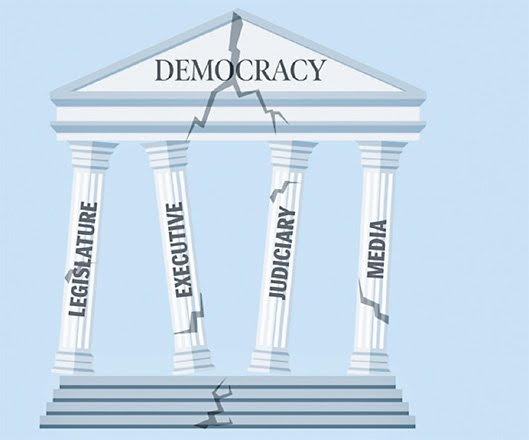Abraham Lincoln’s seminal words “Democracy is government of the people, by the people and for the people” perfectly embodies the vastness of this concept in a straightforward manner. While these words are engraved in our minds, the hefty meaning that they hold are unknown to many. Simply put, the government in a democracy is meant to be elected by the people from amongst themselves which ultimately works for implementing the will of the people.
To ensure this we have institutions like the Legislature (makes laws), Executive (implements laws) and Judiciary (interprets laws) forming the 3 pillars of any Democracy. The ‘Doctrine of Separation of Powers’ enables separation, distinction and independence of these institutions, enforcing guarantee against attempts at tyranny. In addition, the ‘Theory of Checks and Balances’ gives power to each pillar to prevent the others from becoming totalitarian and to prompt the others to perform their constitutional duties.
With the advent of the digital age, political thinkers started to consider the Media as a pertinent 4th pillar. Together these work as a well-oiled machinery propelling the wheels of progress promoting prosperity in a nation. Comparing these idealistic statements to the reality of India, we can notice an overarching role of the Executive, mainly the government in power, over the other 3 institutions. Why do I say so? What evidence do I have? Let us look into the intricacies of this claim.
The Executive & The Media
If information is the currency of democracy, media houses are nothing short of commercial banks transacting in that currency. By this logic, media houses and inevitably the journalists have a moral responsibility to uphold. This is the responsibility of setting aside all prejudices while wearing the hat of a professional. This responsibility becomes furthermore weighty when that professional is one who has millions of people under the influence of his/her words. Talking about influence having journalists, Mr. Arnab Gosawmi is yet again at the center stage of another debate only this time he’s tongue (read hands) tied. The arrest of Mr. Goswami has instigated a big political tussle between the central government and a state government.
Mr. Amit Shah’s tweet in support of a person accused of abetment to suicide, blamed a party of the ruling alliance in Maharashtra for the arrest of Mr. Goswami, hinting that he and thereby the party he belongs to, considers the entire act of arresting as a wrongdoing and not the crime itself. But the nation wants to know, why is this support being meted out? Is it because Mr. Goswami has presented a rosy picture of the said party’s policies and shut down its critique, often by terming the one presenting it as anti-national? Why is it that the leaders of his political party didn’t jump for the defence of other journalists like Siddique Kappan, Prashant Kanojia etc. arrested in U.P. for ‘conspiring against the government’? Has Art. 14, equality before law and Art. 19, freedom of speech and expression of our Constitution been reduced to skimpy text? Then again the blame might just have some credibility attached to it as the timing of the arrest by the police (a subject under the State List) does seem a bit shady.
The Executive & The Judiciary
An independent judiciary is the crown jewel of a democracy. It is too precious to be used as a means of placating a political party’s base. To dodge this bullet, the collegium system, for the appointment and transfer of judges, was finalised in the Third Judges Case, 1998. Fortunately or unfortunately, it exists as merely an advisory body. That is to say that despite the government accepting the recommendations of the collegium, the penultimate order of appointment can be altered by the government in power, as a form of self suited chastening, exemplified in the case of Js. K.M. Joseph who declared President’s Rule in Uttarakhand as void.
The poignant Ayodhaya verdict being considered as an accomplishment of a particular political party rather than the collective wisdom of the Supreme Court is a wrong precedence to set which sends a message to the masses that the government in power can masterfully sway the decision of the judiciary, hampering its independence and blatantly flouting the ‘Doctrine of Separation of Powers’.
Historically, the judicial branch has often been the sole protector of rights of minorities against the will of majority but how is the Judiciary to protect others when it cannot protect itself?

These are all questions to ponder upon. All this isn’t just about a single political party, these just happen to be the contemporary occurrences. There are several appalling instances, in the past like Mr. Robert Vadra case, Mr. Shashi Tharoor case etc., of flagrant biffing of rules. All these erode the confidence that you and me, the common people, have on the institutions that were meant to be citizen centric. The politicians who should have been the servants of society have forced the society to bow down in servitude. After all, it’s the era ‘of the politicians, by the politicians and for the politicians.’
A Finance graduate and amateur writer, trying to articulate her thoughts while driving change and figuring out the new order of society. Born and brought up in Shimla, an environmentalist at heart and activist in thought.




Hello Arusha Gupta and The Hill Post, I am inspired by your article and the illustration of the fractured pillars of democracy. I am a painter. May I have permission to make a painting using your depiction of “The Crumbling Pillars of Democracy”? If so, I will give proper attribution to you and The Hill Post.
Thank you for your kind consideration.